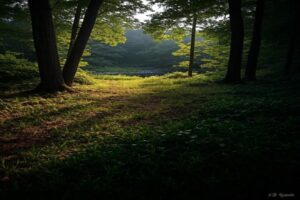In the vast tapestry of nature, there exists a symphony composed not by human hands, but by the subtle movements and vibrations of the natural world. Scientists delving into this enchanting realm have discovered a fascinating phenomenon: music created by trees and mushrooms. Yes, you read that right — nature itself is composing its own melodies, and we’re just beginning to tune in.
Imagine wandering through a dense forest, surrounded by towering trees swaying gently in the breeze. As you walk, you might not realize that each rustle of leaves and every creak of a branch is part of a larger, harmonious composition. Scientists have developed specialized equipment to tap into this unseen world of sound.
By attaching sensitive instruments to trees and mushrooms, researchers can detect the subtle vibrations produced by their movements. These vibrations, when amplified and played through a speaker, reveal a mesmerizing array of sounds. Each tree, each mushroom, has its own unique voice, its own musical signature.
Picture the majestic oak, its deep roots reaching into the earth, emitting a low, resonant hum like the rich tones of a cello. Contrast that with the delicate melody of a birch tree, its slender branches dancing in the wind, producing a light, airy tune reminiscent of a flute. Even mushrooms, often overlooked in the realm of sound, emit faint but distinct vibrations, creating a soft, ethereal background music. The sounds are actually incredible, each unique and powerful. I’m sure experiencing them in person is quite intense. We each have access to this symphony when we quiet ourselves and spend time out with these majestic beings; hearing it on an amp is second to none.
But it’s not just the individual sounds that captivate researchers; it’s the way these natural musicians interact with each other. In a forest, trees communicate through underground networks of fungi, exchanging nutrients and information. This complex web of connections also serves as a conduit for sound, allowing trees to harmonize with one another in ways we’re only beginning to understand.
The frequencies emitted by these natural musicians span a wide range, from the deep, earthy tones of the lower registers to the light, airy notes of the higher ones. Some frequencies are so low that they’re felt more than heard, vibrating through the very ground beneath our feet. Others are so high-pitched that they’re beyond the range of human hearing, yet they still play a vital role in the symphony of the wild.
What makes this natural phenomenon even more beautiful is its impermanence. Unlike human-made music, which can be recorded and replayed endlessly, the music of nature is ever-changing, influenced by the shifting winds, the passing seasons, and the dance of sunlight filtering through the canopy. Each moment is a unique composition, never to be replicated exactly the same way again.
As we continue to explore the depths of this natural symphony, we gain not only a deeper understanding of the world around us but also a newfound appreciation for its beauty and complexity. So the next time you find yourself wandering through a forest or meandering through a mushroom-filled glade, take a moment to listen — you just might hear the music of nature playing its timeless melody for all who care to listen.



